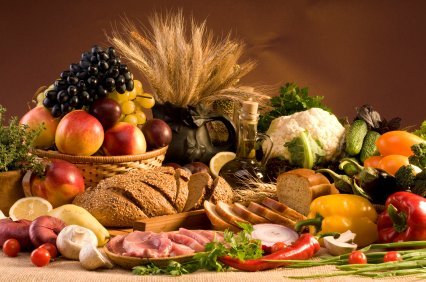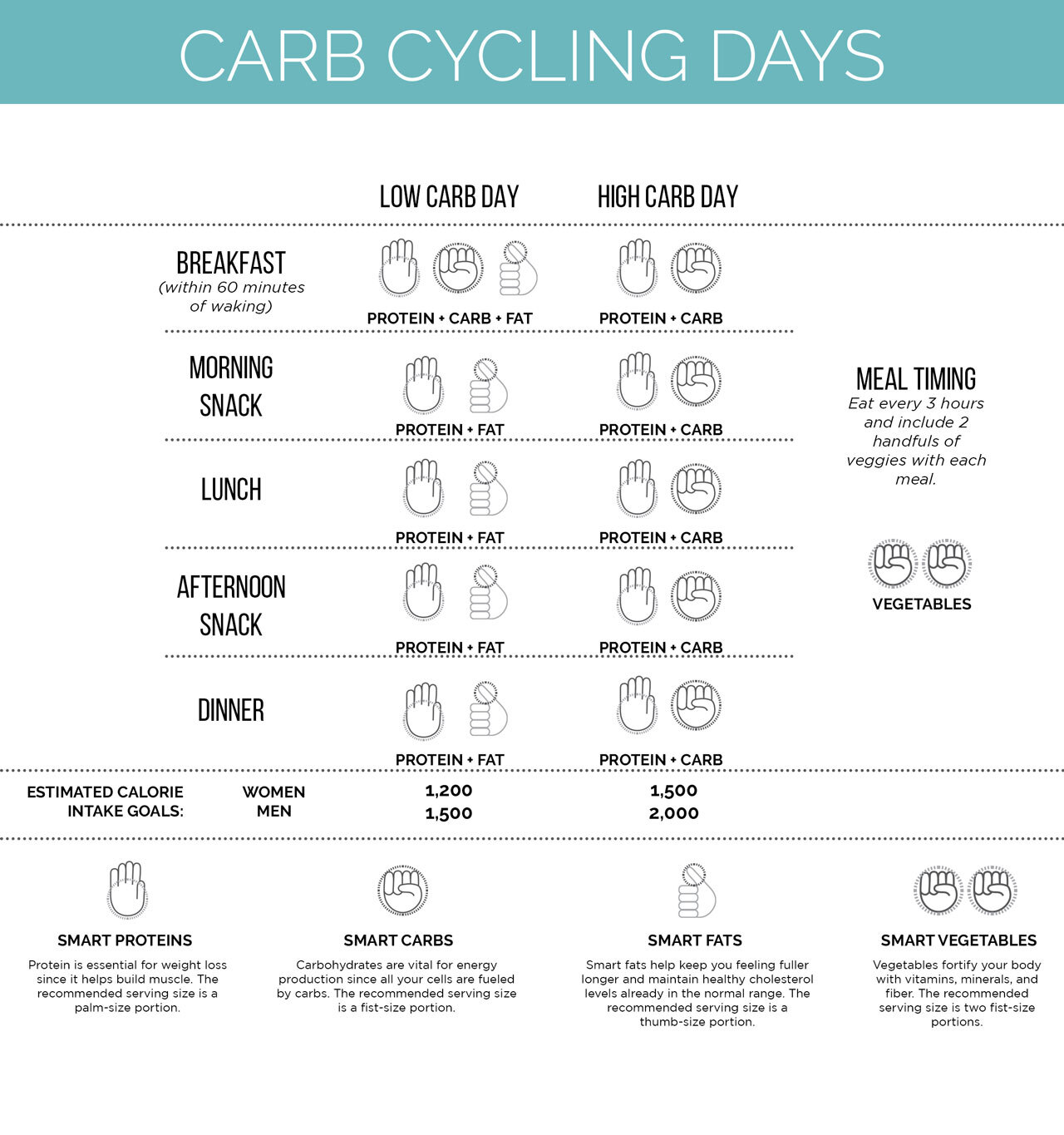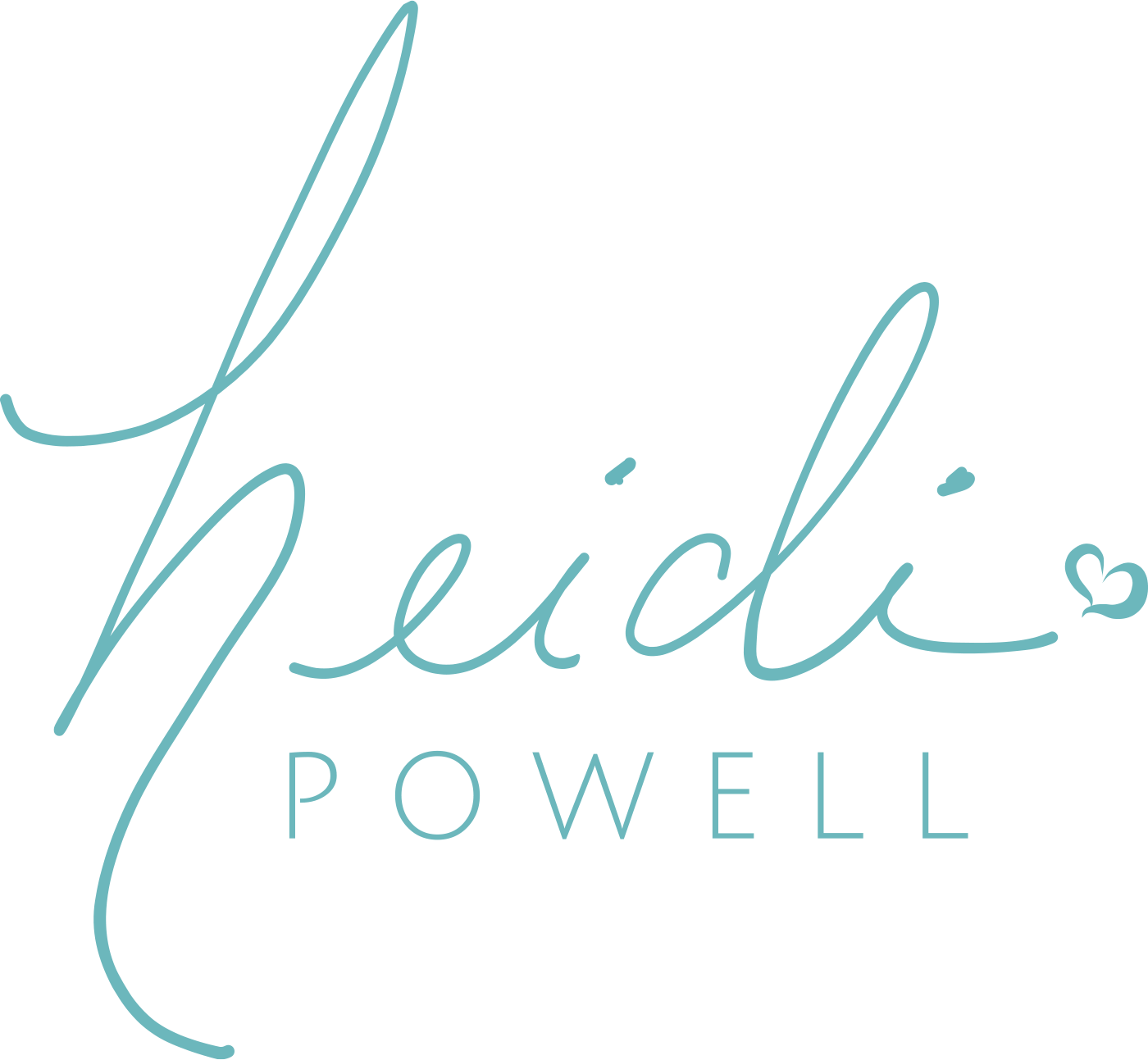Confused about carbs and how they fit into carb cycling? Believe me, you’re not alone! Many of my most frequently asked questions are about carbs. And yes, with all the talk of “carbs this” and “carbs that” in the media, it can get a bit confusing. It gets even more complicated when you think you need to keep track of grams of carbs per meal and per day and the “good” vs. the “bad.”
It’s time to rethink how you think about carbs, agreed?!
First, the basics: Carbs—and the roles they play in your diet—are actually pretty simple. If it comes from a plant, it’s a carb, and carbs are the preferred fuel source for your muscles and organs. Breads, beans, potatoes, table sugar, fruits, and vegetables are all carbs.
There are two categories of carbs: simple and complex. The simple, not-so-healthy ones are found in foods such as cakes, cookies, some commercially made breads, and many processed foods. Fruits are also considered simple carbs because of the type of sugar they contain, but they’re a healthy choice because they’re loaded with vitamins, minerals, electrolytes, antioxidants, and some fiber. Your body breaks down simple, not-so-healthy carbs very quickly, which spikes your blood sugar levels and stimulates the release of insulin, resulting in a craving for more simple carbs. And that is soooo not good!
Complex, healthy carbs—like those found in legumes, root vegetables, whole-grains, cereals, breads, and pastas—are typically high in fiber, which slows food digestion and the release of sugars. This keeps your blood sugar and energy levels steady (and longer lasting), so your calorie-burning furnace stays hot and burns more calories! And that is awesome!
So how do carbs fit into our carb cycling program? It’s actually pretty simple. No matter what carb cycle you choose, every breakfast of every day will contain a carb. Every breakfast, every day. Your carb can be a grain, a legume, a starchy or root veggie, or a fruit.
In the Easy, Classic, Turbo, and Fit Cycles, on low-carb days, your remaining four meals (spaced every three hours) consist of a portion each of protein, fat, and veggies (think fibrous green veggies, not the starchy, root kind), and on high-carb days, your remaining four meals (spaced every three hours) are made up of a portion each of protein and complex carbs (grains, legumes, starchy or root veggies, or fruits). To learn more about the new Extreme Cycle, go here. And no matter which cycle you choose, if you’re ever still hungry, you can always throw in a portion of veggies (again, the fibrous greens). Remember: With carb cycling, you can have non-root/non-starchy veggies with every single meal (starchy, root veggies, like potatoes, will fall into the carb category)! Pretty simple, right?
Here’s what it looks like, including some handy portion size helps, for the Easy, Classic, Turbo, and Fit Cycles:
Here’s the most important take-away about carbs: With carbs and carb cycling, it’s not about a magic number of grams of carbs to eat every day. It’s about that carb for breakfast every morning and spreading your carb intake throughout your high-carb days so your body gets the greatest benefits from those healthy carbs you eat. Carbs are amazing, and they can be an important key to achieving your transformation goals. 🙂




693 Responses
My doctor recently recommended a low carb, high protein diet. I have been reading about Carb cycling and I think I would like to give it a try. How is it different than what my Doctor suggests? I want to adopt a healthier lifestyle and not look at it as so much of a diet. My main vice right now is iced mochas. I’ve developed my own recipe that satisfies my sweet tooth, but I’m looking for a healthier milk alternative and a sugar alternative as well. Thank you for any help you may provide!
Hi Kris: To correctly answer your question, it depends on what your doctor means by low carb. In Chris and Heidi’s program, there are both low and high carb days, protein is the foundation of all 5 daily meals, and fats are included as well. The graphic in this post outlines how to put those days together, so you might chat with your doctor about carb cycling and see what he/she thinks. As far as sweeteners, Chris and Heidi recommend Stevia and xylitol, and unsweetened almond or soy milk as alternatives to milk. Hope that helps!
How meticulous do you need to be watching your macros? And is there some type of formula to know how much of each you should be eating? Loving carb cycling….
Hi Karen: The graphic in this post outlines how to put all your meals together, so as long as you’re following the guidelines, your macros should be right in line. We don’t count grams of anything in carb cycling – just portion sizes (and calories if you wish), which makes things so much easier!
Do you have a real life sample of a low carb/high carb meal?
Would this work?
A typical low-carb day:
7 a.m: two scrambled eggs with 1/2 red bell pepper
10 a.m:?protein shake with berries
1 p.m: 3 ounces grilled chicken with 1 cup asparagus
4 p.m: 1/3 cup oatmeal with 10 almonds
7 p.m: 3 ounces steak with 2 cups steamed broccoli and cauliflower
A typical high-carb day:
7 a.m: 1/2 cup oatmeal with walnuts and berries
10 a.m: apple with 2 tablespoons peanut or almond butter
1 p.m: half turkey sandwich on whole-wheat bread
4 p.m: 1 cup three-bean salad with 1 cup quinoa
7 p.m: 3 ounces grilled chicken with 1 cup whole-wheat pasta and pesto
Hi Brienne: I’ve copied part of your post below for easier answering:
A typical low-carb day:
7 a.m: two scrambled eggs with 1/2 red bell pepper (egg whites only – yolks count as fats – need 4 egg whites for a complete protein, need to add a carb – every breakfast is a high carb meal)
10 a.m: protein shake with berries (no berries, berries are carbs – no carbs on low carb days, need to add a fat)
1 p.m: 3 ounces grilled chicken with 1 cup asparagus (need to add a fat)
4 p.m: 1/3 cup oatmeal with 10 almonds (need to add a protein, no oatmeal since oatmeal is a carb)
7 p.m: 3 ounces steak with 2 cups steamed broccoli and cauliflower (need to add a fat)
A typical high-carb day:
7 a.m: 1/2 cup oatmeal with walnuts and berries (no nuts/fats, need to add a protein, make sure your oatmeal + berries isn’t more than 1 portion of carbs)
10 a.m: apple with 2 tablespoons peanut or almond butter (no nuts/nut butters on high carb days, need to add a protein)
1 p.m: half turkey sandwich on whole-wheat bread (make sure your turkey = a whole protein portion, can add a veggie)
4 p.m: 1 cup three-bean salad with 1 cup quinoa (need a protein, and too many carbs – both beans and quinoa count as carbs)
7 p.m: 3 ounces grilled chicken with 1 cup whole-wheat pasta and pesto (can add a veggie if you’d like)
Here’s how to put together your meals:
Low carb meal: protein + fat + veggies (non-root/non-starchy type)
High carb meal: protein + carb + veggies (if you’re still hungry)
Hope this helps – it’s a bit confusing at the beginning, but you’ll get it! 🙂
HIGH carb day dressing: It is my understanding you can’t have fat on a high carb day but I see that you can have vinaigrettes but they have oil which is a fat so which ones can I have.
Hi Scott: Salad dressings (fat-free/reduced fat/low fat) are considered flavorings, so you can have them with any meal. The serving size is 2TBSP, and be sure to count those calories because they can add up pretty quickly. Hope that helps!
Hello,
I have been looking into this for a while and would like to start Monday. I like to do all my grocery shopping for the week on one day. So in trying to get my list together and to plan my meals, is there anywhere I can find an approved foods list?
Hi Kristin: There’s an approved foods list in Chris and Heidi’s book, “Choose More, Lose More for Life.” Here’s a post that will give you some ideas on protein sources: https://heidipowell.net/7139/the-power-of-protein/, as well as the info in this post for carbs. As for fats, think cheese/reduced fat cheeses, nuts, nut spreads, avocado, olives, etc. Good luck!
I love love EWL and Heidi’s blog!!! Heidi and Chris inspire me to be healthier. I am confused on how many calories my husband and I should eat. We are doing cardio 3-5 times a week and lifting weights 5 times a week. If we are working out that much do we need more calories then the amounts in Choose to Lose? Also how many protein shakes do you recommend daily? I am close to my goal weight, but really want to be more muscular, any advice?! Thanks for all u both do ?
Hi Heather: The answer to your question depends on how close you are to your goal weights and how intensely you work out. Try following the calorie recommendations (women: 1200 on low carb days and 1500 on high carb days / men: 1500 on low carb days and 2000 on high carb days), and if you need to, you can adjust your calories to support your workouts. Doing so could slow down your rate of weight loss, so please keep that in mind. As for protein shakes, try to stick to one a day to make sure you’re getting enough whole foods in your diet. And the best way to build muscle is to eat healthy and work those muscles, so you’re definitely on the right track!
If I?m doing a Powell Perfect shake for breakfast on low carb day, do I still add some fat like peanut butter? Also, can I add a green super food powder as well- will that count as a serving as veggies?
Since every breakfast is a high carb meal, you won’t want to add any fats, and your Powell shake counts as both the protein and carb portions of that meal. You can add the green super food powder if you’d like to, but make sure you’re getting some whole veggies in your diet too. Hope that helps!
I’m intrigued by this plan and thinking about trying it. I exercise 6 days a week and I am a distance runner. I run my long runs on M, W, S and run a 4-5mile tempo run on T, Th followed by strength training, and a 5-6mile run F followed by strength training. I’ve never been overweight and I am fit now but looking for ways to get even more lean. My first question is: do I need to figure out how many calories I need to support my training and fit that into the carb cycling plan? Second: you guys say to eat breakfast within 30min of waking up. I get up really early to exercise so I can do it while my kids are still sleeping (they are 3 and 1). I can’t eat a meal that large right before I exercise. I normally eat half a protein bar or a small bowl of cereal with almond milk before I workout and then breakfast after. Can I do that if I allow 3 hours between those meals? Does that pre-workout snack count as a meal?
Hi Brie: Let’s get you some answers to your questions! 1. With your intense workout plan, I’d start with the Fit Cycle (https://heidipowell.net/2719/carb-cycling-the-fit-cycle/), and if you need to, adjust your calorie intake to allow you to be able to workout as you’d like to. If you do adjust your calories, make sure one thing you add is more lean protein. 2. Here’s a post that will help you with your eating and working out question: https://heidipowell.net/9194/qa-with-the-powells-to-eat-or-not-to-eat/. Welcome to carb cycling!
Hi There! I just started carb cycling this week, still getting the hang of things! And I think I may have made a protein powder mistake! I spent $30 on a powder (Natureade vegan smart all-in-one), when I got it home I realized that it has a lot of different proteins/ nutrition stuff in it. Bottom line, I don’t think it’s 100% protein, it has 20 g protein a serving, but also 14 grams of carbs?! I already opened it, so I cannot return it. Is it okay to use? Maybe just on high carb days or would it work for low carb too? Or should I scrap it, and call it a $30 mistake?
Hi Alene: No! No need to throw it away. You can use it for high carb meals, and it equals a protein and 1/2 (ish) a carb serving, so just add a 1/2 a carb, and you’re good to go! For a powder that counts only as a protein portion, choose one with between 15-20 grams of protein and less than 5 grams of carbs per serving. Welcome to carb cycling!
Hi! We’re just starting out on our carb cycling journey and I had a question. Is it okay to skip the flavor portion of a meal? Like if on a low carb day if I have a meal of cottage cheese, almonds, and carrots, will this be complete? Or are the amount of calories in the flavorings necessary in the weight loss process? Thanks!
Hi Heather: Yes, you can skip the flavorings whenever you’d like. They are totally optional. Welcome to carb cycling!
If I’m doing a Powell Perfect shake for breakfast on low carb day, do I still add some fat like peanut butter? Also, can I add a green super food powder as well- will that count as a serving as veggies?